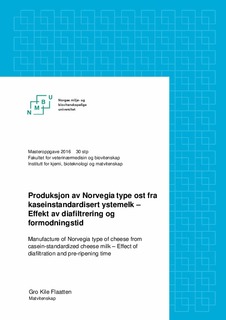| dc.contributor.advisor | Skeie, Siv | |
| dc.contributor.author | Flaatten, Gro Kile | |
| dc.date.accessioned | 2016-08-10T12:38:59Z | |
| dc.date.available | 2016-08-10T12:38:59Z | |
| dc.date.issued | 2016-08-10 | |
| dc.identifier.uri | http://hdl.handle.net/11250/2398680 | |
| dc.description.abstract | Norvegia® er Norges mest spiste ost og utgjør en av TINE’s største og viktigste merkevarer. I dette forsøket ble det produsert en Norvegia type ost fra kaseinstandardisert ystemelk der utgangspunktet for ystemelka var et kaseinstandardisert retentat fra mikrofiltrering (MF) av skummet melk. Effekten av forsøksfaktorene diafiltrering og formodningstid ble undersøkt. Standardisering av kaseininnholdet i ystemelk reduserer variasjon i sammensetningen til ystemelk, eksempelvis sesongvariasjon, og dette kan bidra til å standardisere ystingsprosessen ytterligere. Ysting med kaseinstandardisert ystemelk kan øke utbyttet av ost per ystekar og dermed bidra til å øke ysterienes kapasitet. Kaseinstandardisering av ystemelk ved mikrofiltrering muliggjør i tillegg utvinning av en nativ mysefraksjon, som utgjør et utmerket råstoff til diverse myseproteiningredienser.
En viktig del av arbeidet omhandlet utvikling av en ystingsteknikk for Norvegia type ost fra kaseinstandardisert ystemelk. Det ble utført et forforsøk der det ble ystet et kar MF retentat for å teste ystingsteknikken, samt bestemme ostens saltetid. Etter forforsøket ble det foretatt modifikasjoner i ystingsteknikken, der de viktigste endringene omhandlet endringer i skjære- og røreprogram for å begrense klumpdannelse i ystekarene. Hovedforsøket ble utført i tre blokker og forsøksdesignet hadde to faktorer med to nivåer. Halvparten av MF retentatet ble diafiltrert (DF), og for hver ysting ble det produsert to ystekar fra både DF- og MF ystemelk (fire totalt). Hensikten med diafiltrering var å standardisere laktoseinnholdet i ystemelk i forkant av ysting og dermed utelate mysefortynning fra ystingsprosessen. Dette gjorde at ysting fra DF ystemelk gikk noe raskere og var svært mye enklere å utføre. Det ble anvendt to nivåer av formodningstid under ysting, 45 og 90 minutter, for å undersøke om ulike pH nivåer under ysting påvirket ostens egenskaper.
Ost produsert fra DF- og MF ystemelk hadde ulike egenskaper. DF ost hadde en lavere pH enn MF ost. Det var også store forskjeller i ostens konsistens der MF ost generelt hadde en fastere og mer elastisk karakter enn DF ost. Tørrstoffinnholdet var høyest i osten med lengst formodningstid. Forsøket viste at både MF- og DF ystemelk kan være egnet ved produksjon av Norvegia®, men at det fortsatt er mye gjenstående arbeid før en eventuell industriell implementering av denne ystingsteknikken. | nb_NO |
| dc.description.abstract | Norvegia® is the most consumed cheese in Norway and represents one of TINE’s biggest and most important brands. In this experiment, a Norvegia type of cheese was manufactured from casein-standardized cheese milk. The raw material for the cheese milk was a casein-standardized retentate from microfiltration (MF) of skimmed milk. The effect of the experimental factors diafiltration (DF) and pre-ripening time was investigated. Standardizing the casein content in cheese milk reduce the variation in cheese milk composition, e.g. seasonal variation, which may further standardize the cheesemaking process. Cheese manufacture from casein-standardized cheese milk may increase the yield in the cheese vats and this may also increase the capacity of the cheese factories. Casein-standardization also allow recovery of a native whey fraction, which is an excellent raw material for different whey protein ingredients.
An important part of this thesis was the development of a cheesemaking technique for manufacture of a Norvegia type of cheese from casein-standardized cheese milk. A trial experiment was conducted in order to test the cheesemaking technique, and to decide the salting time for the cheese. After the trial experiment some modifications of the cheesemaking technique was conducted, where the most important changes regarded modifications in the cutting- and stirring programs to avoid formation of lumps in the cheese vats. The main experiment was replicated three times and the experimental design consisted of two factors with two levels. Half of the MF retentate was diafiltered, so that on each production day, two cheese vats were manufactured from both DF- and MF cheese milk (four in total). The purpose of diafiltration was to standardize the lactose content of the cheese milk prior to cheesemaking in order to exclude curd wash from the cheesemaking process. This made cheesemaking from DF cheese milk somewhat faster, and also very much easier to conduct. Two levels of pre-ripening time were used in the cheesemaking, 45 and 90 minutes, to investigate whether different pH-levels during cheesemaking affected the cheese quality.
Cheese made from DF- and MF cheese milk had different properties. The DF cheese had a lower pH than the MF cheese. There were large differences in the consistency of the cheese, where the MF cheese, in general, had a firmer and more elastic character than the DF cheese. The dry matter content was highest in the cheese with the longest pre-ripening time. The experiment showed that both DF- and MF cheese milk may be used in the manufacture of Norvegia®, but also that there is still a lot of work remaining before an eventual industrial implementation of this manufacturing technique. | nb_NO |
| dc.language.iso | nob | nb_NO |
| dc.publisher | Norwegian University of Life Sciences, Ås | |
| dc.title | Produksjon av Norvegia type ost fra kaseinstandardisert ystemelk : effekt av diafiltrering og formodningstid | nb_NO |
| dc.title.alternative | Manufacture of Norvegia type of cheese from casein-standardized cheese milk - Effect of diafiltration and pre-ripening time | nb_NO |
| dc.type | Master thesis | nb_NO |
| dc.subject.nsi | VDP::Technology: 500::Food science and technology: 600 | nb_NO |
| dc.source.pagenumber | 116 | nb_NO |
| dc.description.localcode | M-MAT | nb_NO |
